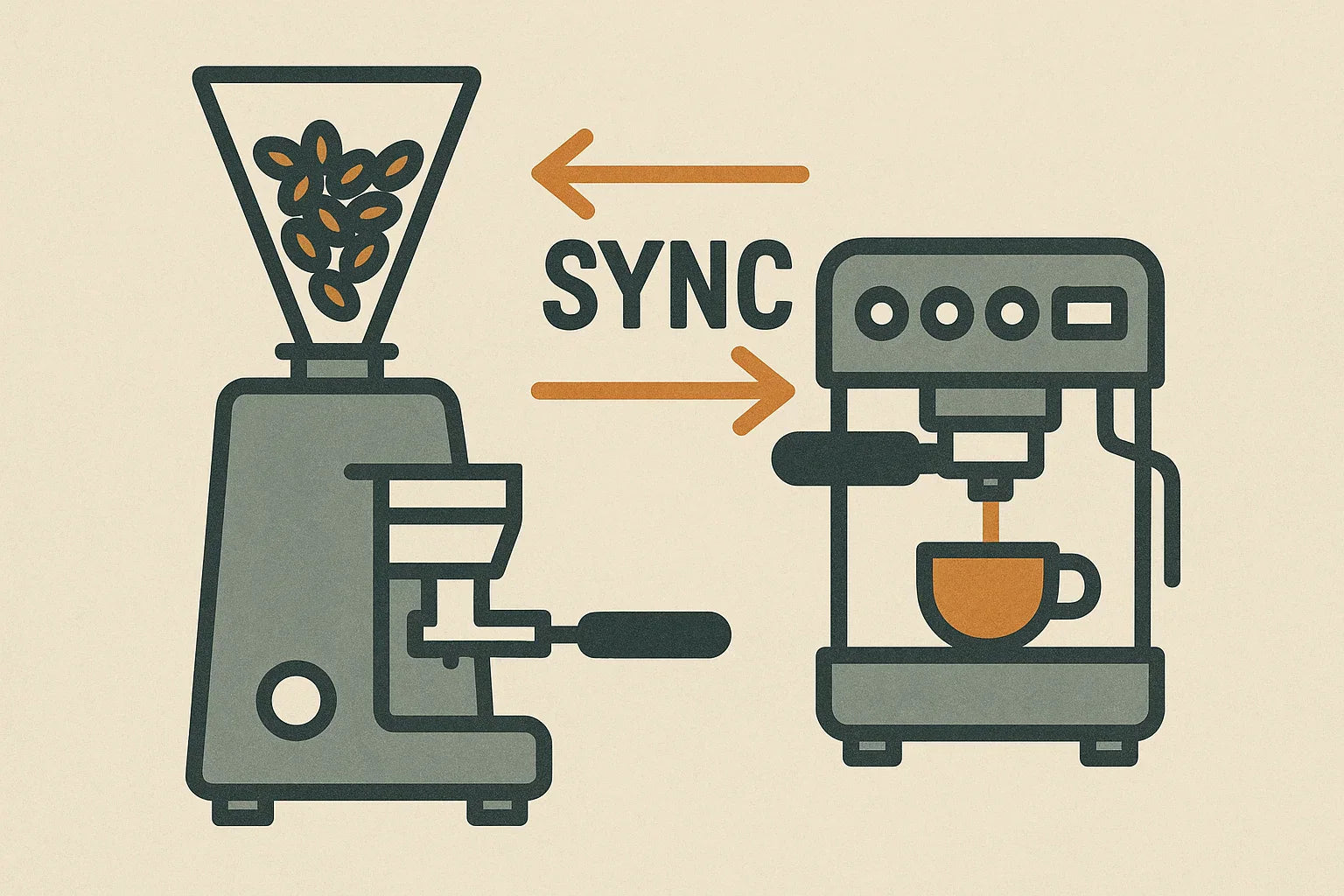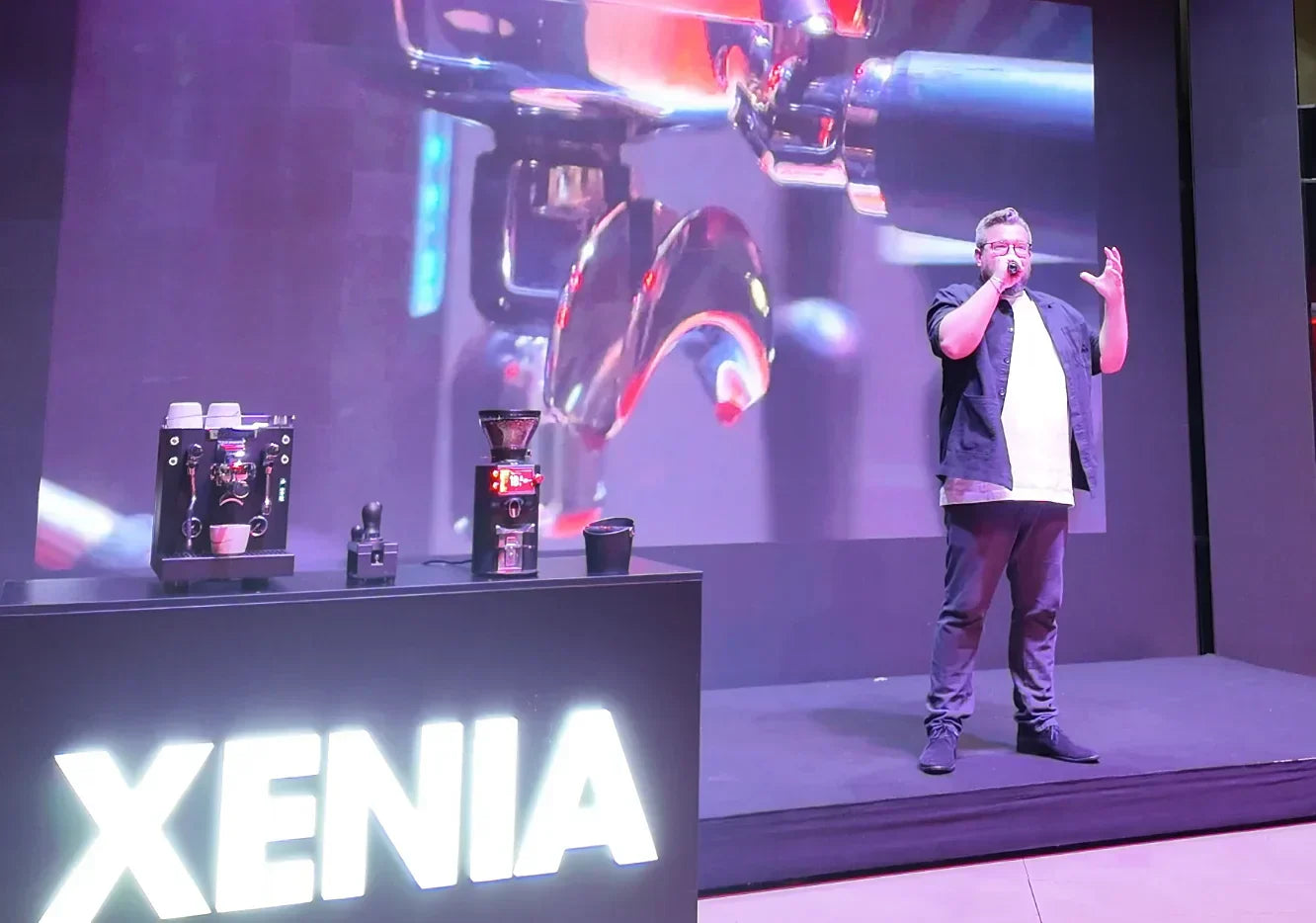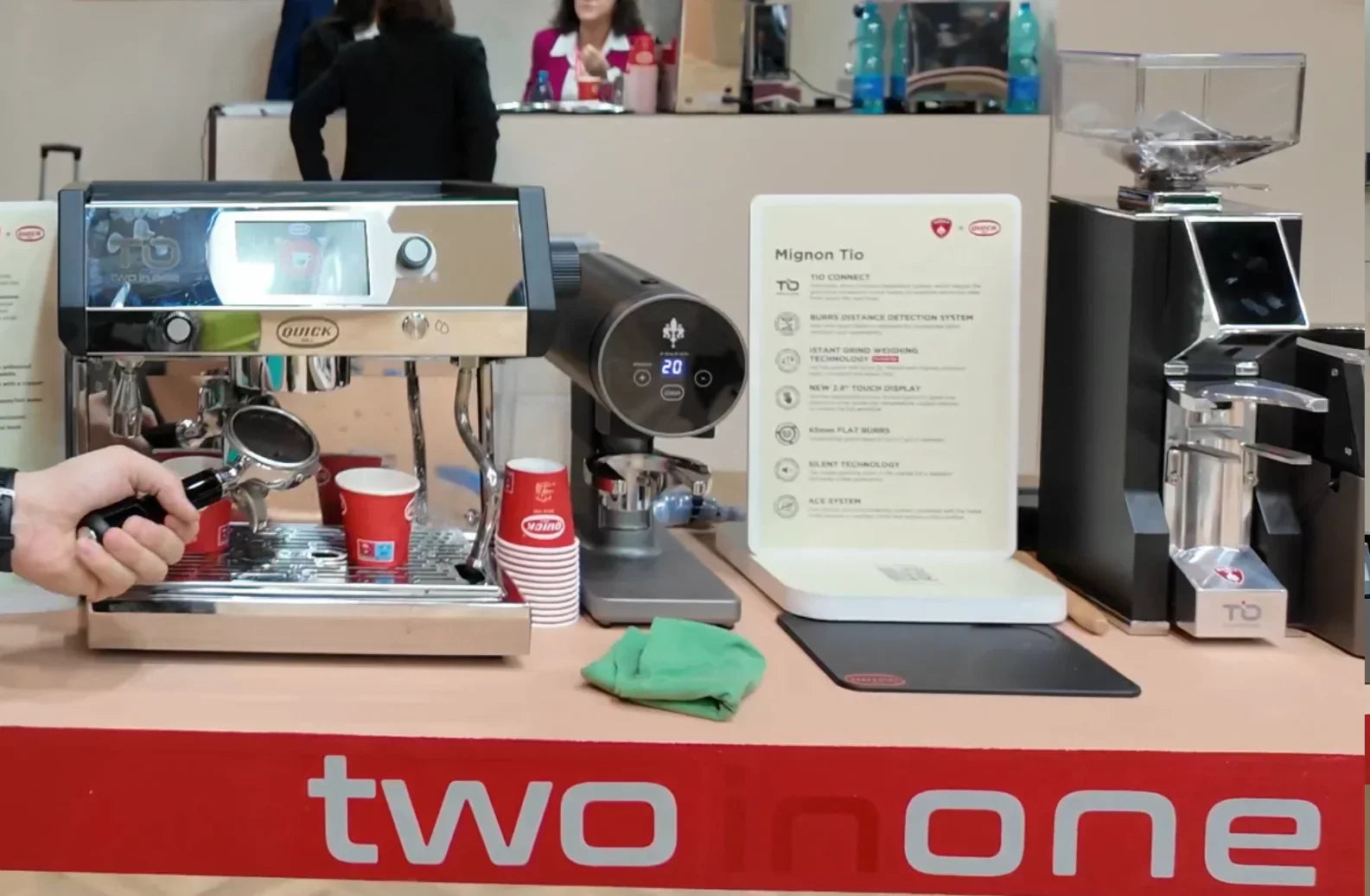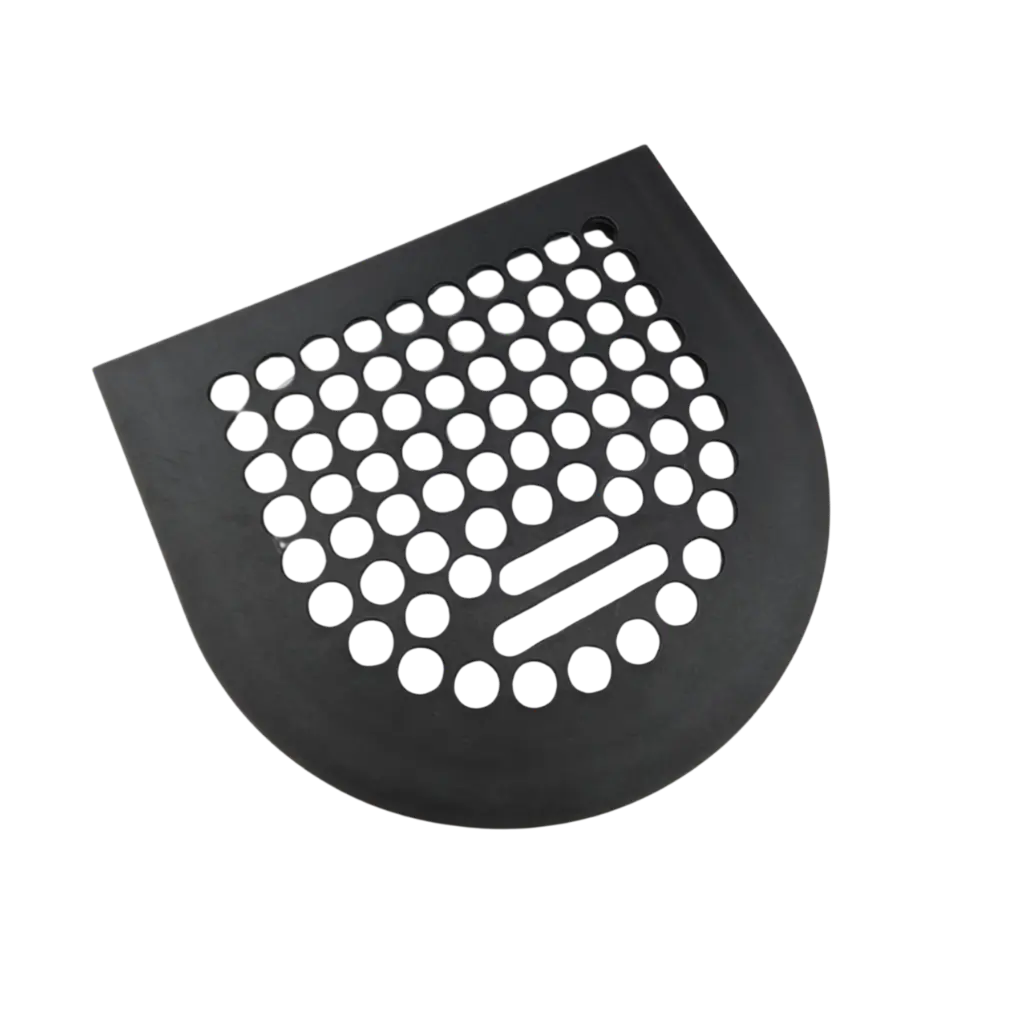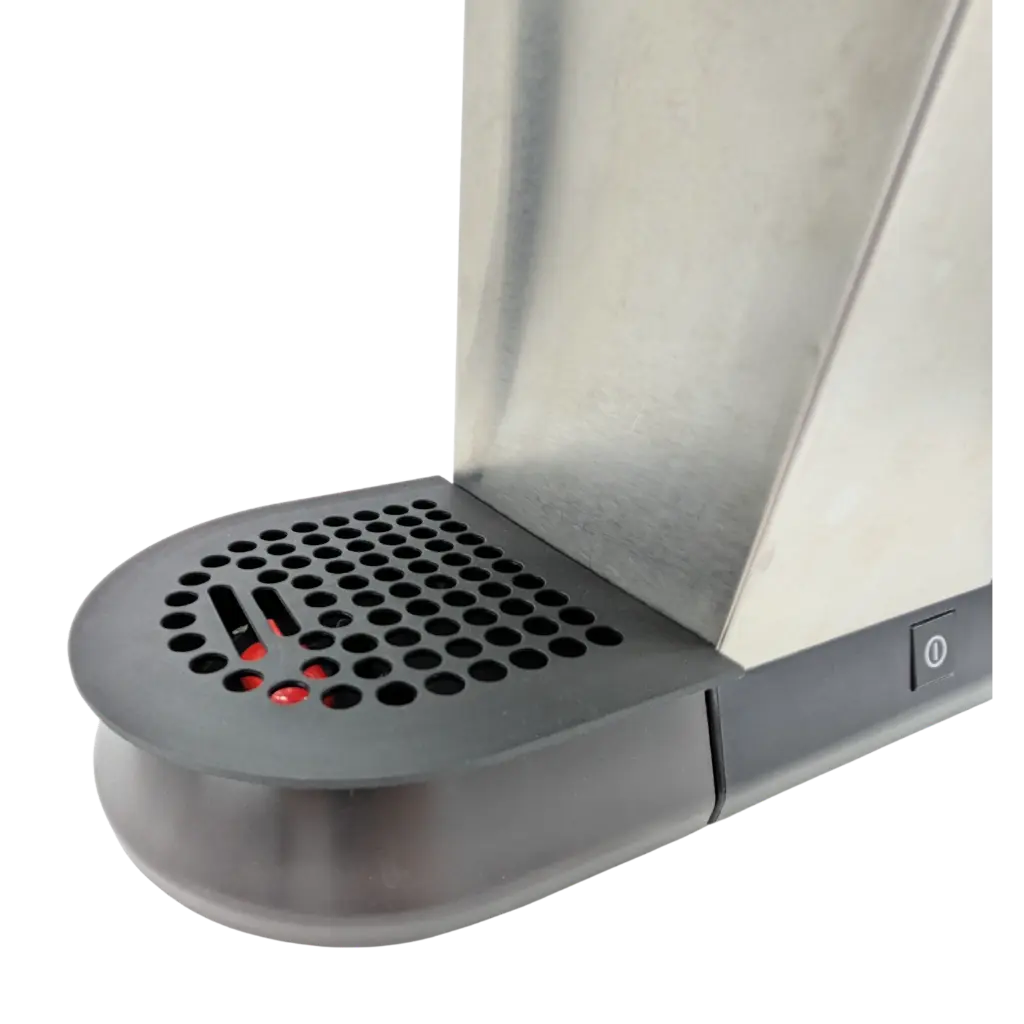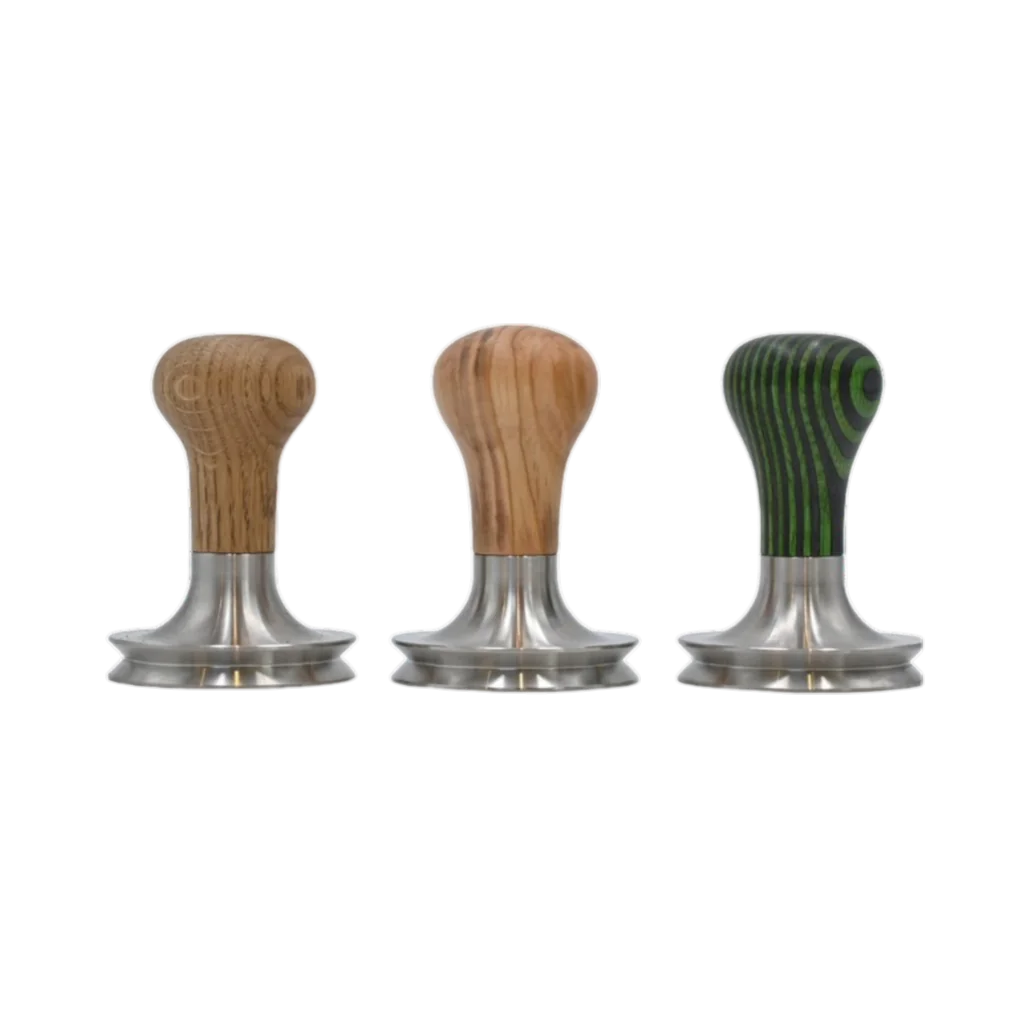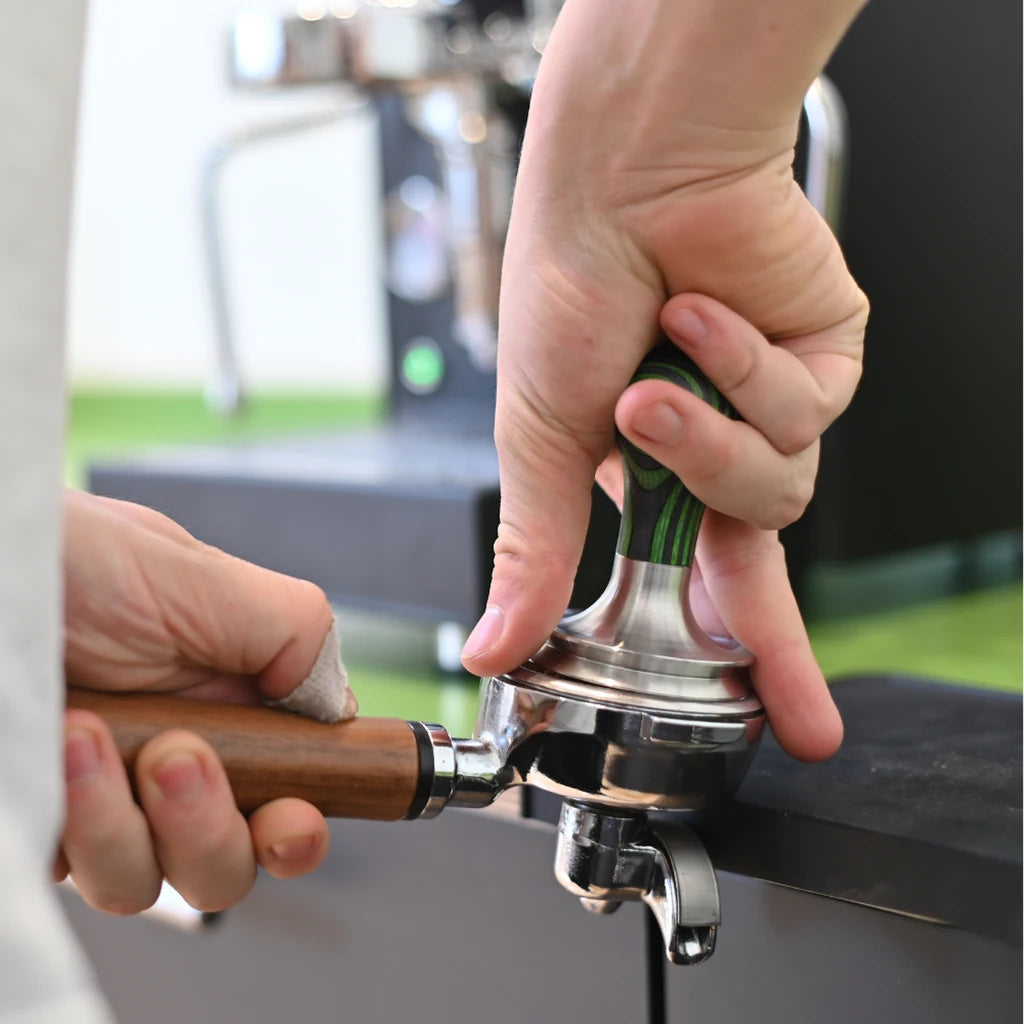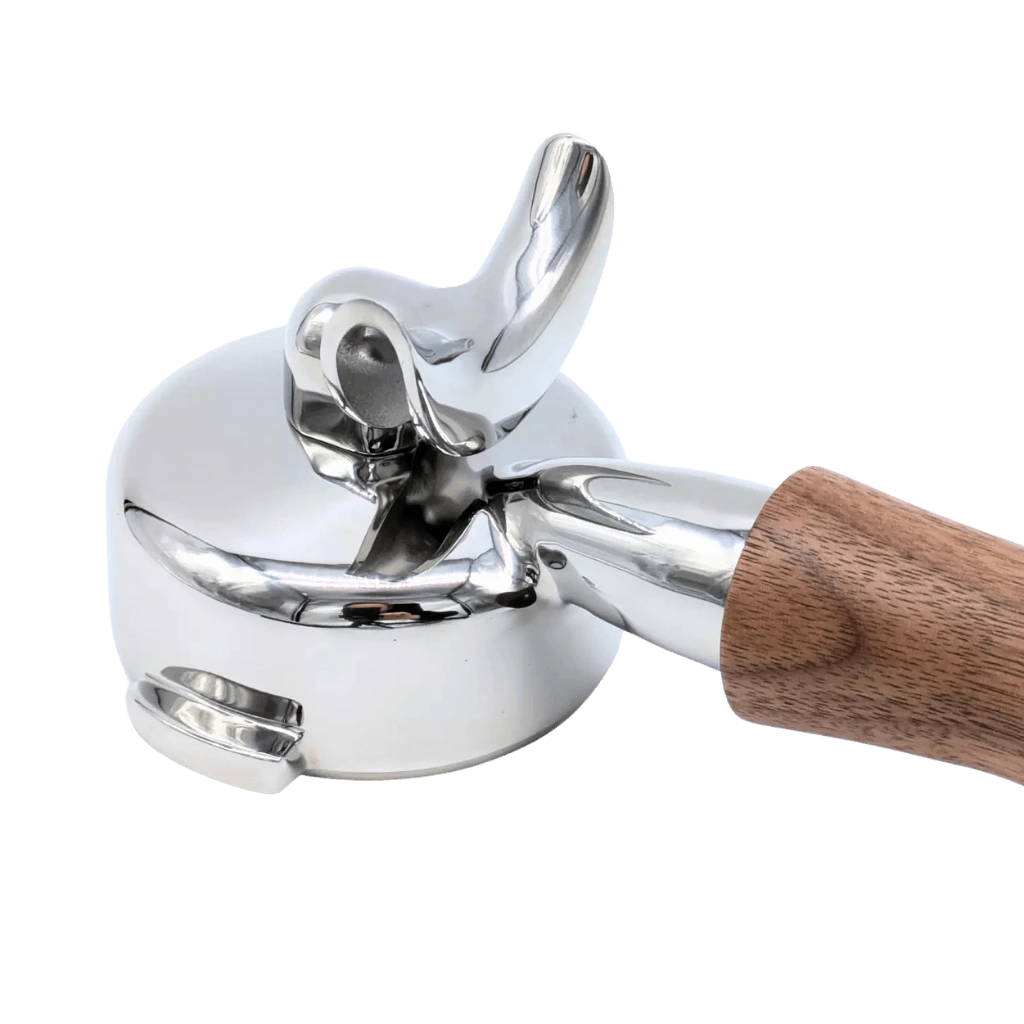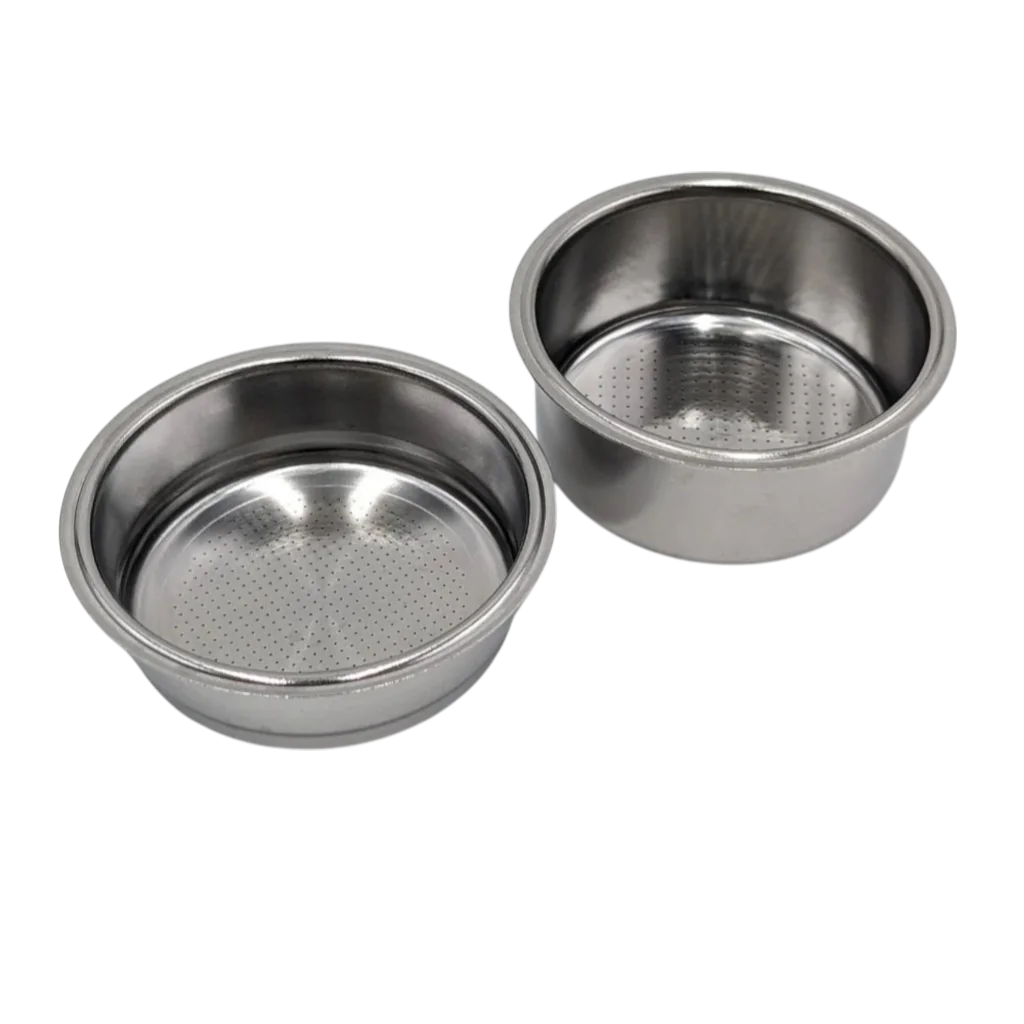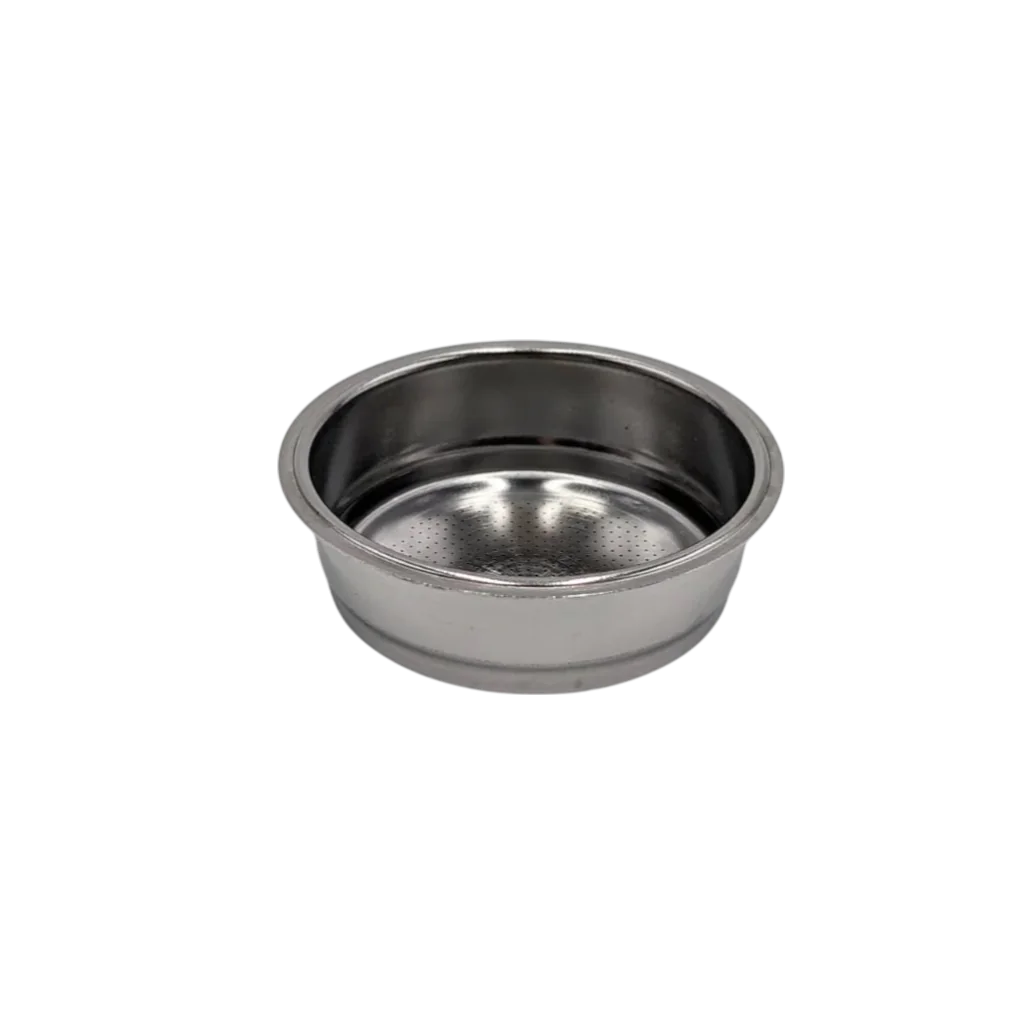
Sage Smart Grinder Pro – the best entry-level espresso grinder?
Reading time 5 minutes: This is a short blog, you can find the more detailed version here on our Swiss website.
A good grinder for getting started in the world of espresso. There is a lot to suggest that we have found it with the Sage Smart Grinder Pro. With this test we are responding to many inquiries that have reached us by email. Our community is looking for an affordable entry-level grinder that is easy to use and provides the joy of fresh, properly ground espresso. We already tested the Sage Smart Grinder Pro in April 2020 and included it in our large espresso grinder comparison in 2022.
And the Smart Grinder Pro was convincing in both tests. For us it is and remains one of the most interesting mills to get started with.
What criteria are important to assess the quality of an espresso grinder?
- Does the grinder grind espresso fine? This is important so that enough resistance can be built up for the water and the desired throughput time of approx. 25 seconds is achieved.
- Is the ground material homogeneous? Ideally, the majority of the ground material is in the set range with a few outliers upwards or downwards. Too many outliers make the espresso too bitter or too sour.
- Easy to use: Can the grinding level be adjusted easily and as smoothly as possible?
- Consistency: Does the machine give consistent grinding results or is every grinding process a game of chance?
- Dead space: How much ground coffee remains in the machine after grinding? Too much and the next espresso tastes stale after just a few minutes.
- Warming up with regular use? If the grinding disks heat up, this can affect the taste.
- Does the grinder grind espresso fine? This is important so that enough resistance can be built up for the water and the desired throughput time of approx. 25 seconds is achieved.
Espresso-fine!
The machine does this without any problems. An espresso can be brewed within 25 or 30 seconds. The grinding degree is adjusted using a wheel that is attached to the front of the mill. The digital display shows the grinding level and what it is suitable for (filter, espresso, etc.). This is very clear and well solved.
What's a bit irritating, however, is that the clicks you feel from the wheel don't interact directly with the display. So it happens that we adjust three levels on the wheel, but only move forward two levels on the display. So you shouldn't rely too much on the large display. However, since coffee, as a natural product, is never exactly the same, it is normal that the grinder also needs to be readjusted from time to time.
The thing about the consistency of the espresso grinder
We made 40 espresso shots in a row. Yes, 40 pieces. And the consistency of the machine was impressive. We have set the target amount to 18 grams, which is achieved with the Sage Smart Grinder Pro over the course of a meal. For us it was 16 seconds. In these 40 purchases, the amount of coffee deviated from the target value by a maximum of 0.4 grams. That is really good!
How does the espresso taste and how consistently did it run?
Thanks to the easy-to-adjust grinding level, we were able to quickly and reliably set a good throughput time for our espresso. The espressos tasted balanced and delicious. Strangely enough, the lead time changed from purchase to purchase. If we started with 29 seconds, the tenth reference only ran much faster at 22 seconds. The ground material also warmed up noticeably over the rapid exposure. In the grinder's defense: it is a home barista machine and not a catering machine. It's rare that you drink 30 or more espressos one after the other in your home. If the throughput time is too short, you should simply readjust the mill briefly.
We are pleased with the particle distribution of the Sage Smart Grinder Pro. The main peak of the ground material is high and narrow in our diagram. This means that the vast majority of the ground material ejected is the same size, namely the size you set it to be. Only a small proportion is larger or smaller. This way you can be sure that the majority of your coffee puck in the portafilter is extracted at the right level and does not become too sour (under-extracted) or bitter (over-extracted). You can taste it in the cup too!
Operating the Sage Smart Espresso Grinder Pro
As described above, the machine is easy and easy to adjust. The side wheel and the feedback on the display give you the feeling of knowing exactly what the mill is doing. Compared to its smaller sister, the Sage Dose Control, it turns out that the display is a very helpful tool, especially for beginners, that you can rely on when finding the right grind level.
The default setting for the Sage as delivered is good. The vast majority of espresso beans can be ground well with it. However, it can happen that particularly light roasts fall outside the mill's adjustable range. Then it is necessary to roughly preset the grinding level. To do this, you have to preset the grinding disks from above. We'll show you this in our own video.
Dead space is the ground coffee residue in the grinder
After each grind, a little ground coffee remains in your grinder. It sits in the shaft, in small screw openings or cracks. Since ground coffee loses its aroma very quickly, this so-called dead space has a negative effect on your espresso. So the smaller this dead space is, the better it is. Our test also includes determining this dead space as accurately as possible by dismantling the machine and weighing every little grain.
According to our measurements, the Sage Smart Grinder Pro has a dead space of 2.7 grams of coffee. A grinder like the Niche Zero has almost zero grams, but a Graef CM800 has up to 8 grams of coffee powder in the dead space. Since the Smart Grinder Pro is more in the Graef league in terms of price, you can see that the size of the dead space is acceptable. Nevertheless, if the grinder has been left without grinding for more than 15 minutes, we recommend grinding a few grams of coffee and not using it before starting a new batch.
Nature and conclusion of the Sage Smart Grinder Pro
With its 22 cm width, 38 cm height and 15 cm depth, the mill fits pretty much anywhere. The housing is made of a combination of stainless steel and plastic and is of high quality. Everything feels pleasant to the touch and appears solid. We have not yet tested a better grinder in the price segment in which the Sage Smart Grinder Pro is located. So we can recommend it for beginners.
Finally, it should be said that we do not sell Sage products in our shop and are not paid by Sage for our test reports. We give our honest and as unbiased opinion as possible. If we say the grinder is good, it's because we tested it that way.
Habe den Sage smart grinder pro gemäß Anleitung gereinigt. Leider gibt mahlt die Mühle seitdem nicht mehr. Die Knöpfe Start und shot liefern keine Funktion. Der Motor bewegt sich null, es gibt keine Geräusche. Im Netz finde ich dazu nichts und der Sage Support liefert keine Hilfe. Hat hier vielleicht wer eine Idee was ich noch probieren kann?
Ich habe ein Problem mit dem Mahlgrad, nachdem ich die Mühle einmal komplett gereinigt habe. Habe dazu auch den Mahlkegel herausgenommen, um wirklich unten auch rein zu kommen mit dem Pinsel. Dabei bin ich ganz unten auf einen relativ unhygienisch wirkenden Filzring gestoßen, der sich auch schon beim herausnehmen anfing aufzulösen. Habe ihn dann einfach weggelassen (war eh kaputt), nach dem zurückbauen aller Teile mahlt die Mühle allerdings viel zu grob. Habe auch den Mahlgrad des Kegelmahlwerks innen schon von 5 auf 4 gestellt und bin auf dem Display jetzt bei Mahlgrad 2, vorher im Bereich 8-10. habe ich die Mühle kaputt gemacht? 😅
Mir ist leider das gleiche passiert.... Nach der Reinigung ist der Mahlgrad viel zu grob.
Ich kenne die Aussage, bei der Mahlgradverstellung von grob zu fein, die Mühle laufen zu lassen. Bei der sage grind pro würde das von filter bis espresso so einige steps bedeuten. Ist das bei diesem Gerät denn überhaupt notwendig, oder kann ich im Stillstand einfach runterskalieren?
Danke & Gruß
Udo
man sollte die immer laufen lassen, da sich sonst Kaffeebruchstücke im Mahlwerk verkanten. Wenn du manuell da drüber drehst, dürfte das auf Dauer der Mechanik schaden. Das ist eigentlich bei jeder Mühle so. Ich habe es bei der SGP immer so gemacht, dass ich die umgekippt habe, damit alle Bohnen rausfallen, um nicht soviel Verlust zu haben. Aber selbst dann würde ich sie nachher beim Verstellen laufen lassen. Viel Spaß mit deinem Filterkaffee auf grober Einstellung: nach meiner Erfahrung wird der mit der Mühle richtig gut!
Du kannst den Mahlgrad auch ohne Probleme im Stillstand verändern.
Grüsse
Andrea
Kann mir jemand mit der Speicherfunktion der Mahlzeit helfen!?
Ich verzweifle fast daran..
Wenn ich die Mahlzeit eingestellt habe und dann das Zeitrad reindrücke ertönen zwei Piepstöne, welche mir ja bestätigen sollten, dass die Mahlmenge gespeichert ist. Wenn ich jetzt jedoch die Shot-Anzahl verändere und dort ebenfalls die Mahlmenge verstelle, bleibt die vorher eingestellte Dosis nicht gespeichert und ist wieder der Ursprungswert.
Danke für eure Hilfe!
Mittlerweile habe ich herausgefunden, dass eine programmierte Shotmenge von 1 oder 2 nur abgerufen werden kann, wenn auch der Siebträgerhalter montiert ist. Ich versuchte lange, die programmierte Mahlzeit ohne den Siebträgerhalter zu mahlen. Es funktioniert nur wenn der Siebträgerhalter eingesetzt ist. Dann kann man jedoch unterschiedliche Mahlzeiten programmieren, so wie es sein sollte. :)
Wir haben uns die Sage Grinder pro und die Sage Dual Boiler Maschine im Set gekauft - Sage the Dynamic Duo.
Wir machen seit 2 einhalb Tagen nichts anderes, als das Setting für einen guten Espresso herauszufinden. 2 kg Bohnen später sind wir schon ziemlich frustriert.
Das Mahlwerk auf der niedrigsten Stufe 1, 22 Klicks (Mahlgrad 15), 18,1 Kaffeemehl, 48 ml Espresso in 27 Sekunden, 9 Bar - Geschmack bitter. Bei 21 Klicks (eine Stufe feiner) plötzlich nur noch 7 Bar?
Wir sind wirklich am Ende mit unserem Latein :-(
Wir haben den Mahlgrad im Standby verstellt. Nun hab ich gelesen, dass man das nur bei laufender Mühle machen soll. Ist das korrekt?
Welches Setting ergab bei Euch einen ausgewogenen Espresso? Wir haben auch schon zig verschiedene hochwertige Bohnen probiert.
Mein Mann ist kurz davor eine andere Mühle zu kaufen, aber ich kann nicht glauben, dass wir das mit der nicht auch hinbekommen können.
Vielen Dank fürs Lesen und vorab für Eure Hilfe 🙏
ich bin zwar kein Profi, aber ich kann mal versuchen ein paar Optionen zu nennen. Und nichts davon sollte eine Unterstellung sein. Nur um einiges abzuklappern:
- Kaffeebohnen / Röstung (mit Kaffee aus dem Supermarkt kommt man nicht weit...)
- trotz hochwertiger Bohnen kann das Quellverhalten bei einigen Röstungen sehr herausfordernd sein (Kanalbildung / Channeling) -> Wie sieht der Puck aus?
- Wassertemperatur des Siebträgers (die ist ja auch neu): die könnte z.B. (warum auch immer) zu hoch/tief sein.
- Wie lange sind die Mahlscheiben quasi am Stück im Betrieb? -> Temperatur der Mahlscheiben (nach 1 kg...)
Um von den Profis ergänzt und korrigiert zu werden.
Deine Zubereitung mit den 27 Sekunden scheint übrigens gar nicht so verkehrt zu sein. Daher muss es nicht unbedingt an der Mühle liegen.
(Der Röster meines Vertrauens bei uns in der Stadt nutzt die Mühle auch für Verkostungen. Und da schmeckt der Kaffee. Ich persönlich hatte sie zwar zu Hause, dann aber zurückgeschickt und (dank dem ermutigenden Zureden meiner lieben Frau) gegen eine Eureka Specialita eingetauscht.)
Beste Grüße und gutes Gelingen
Samuel

Dass es am Anfang etwas Zeit braucht ist wirklich ganz normal. Und je nachdem was ihr vorher für Getränke genossen habt, ist das dann schon ein grosser Unterschied. Einfach weiter ausprobieren oder mal einen Kurs oder Online Kurs machen:)
Herzliche Grüsse
Michel
Könnte wer mittlerweile so grob mir verraten, was für MG innen und außen und für wieviel gr. ihr bei der Sage Smart pro Kaffeemühle anwendet (abgesehen von der Kaffeemarke). Vielen Dank.
einige Angaben sind schon hier. Durch Fertigungstoleranzen kann der (äußerlich eingestellte) Mahlgrad tatsächlich immer mal abweichen. Daher kann man das leider nicht so festhalten.
Man könnte aber tatsächlich mal, um das in einer Tabelle festzuhalten, alle in der Community fragen, denselben Kaffee einzustellen und den eingestellten Mahlgrad zu posten.
Ich könnte mir aber vorstellen, dass das Team hier so etwas nicht tun wird, da sie dann alle dazu aufrufen müssten die eigenen Bohnen zu kaufen.
Beste Grüße
Samuel
Ich schaue erst seit kurzem Eure Videos - erstmal Danke dafür!
Habe mir jetzt als Ersatz für meine Graf CM 800 die SGP gekauft, da mir das regelmäßige Abwiegen - und dann wieder Pulver entsorgen - gestört hat. Single Dose reizte mich, konnte mich dem Hype aber noch nicht anschließen :)
Nun nach folgender Einstellung mit dem mir bekannten Espresso
* Quickmill 3004 (ich nenne sie „Zicke“) mit Standard Sieben
* Graf Mühle MG 7 - 15,5gr
Nun also SGP
* inneres Mahlwerk auf 1 ! !
* 14,2 sek auf MG 5 für 14,6g
* 30gr in der Tasse in 30sek
Da stimmt doch was nicht!
Ich werde mit der SGP noch etwas probieren, warte auch noch auf modifizierte Siebe.
Aber mit dem Setup bin ich nicht zufrieden.
Habt Ihr da einen Ansatz?
Ganz herzlichen Dank für Tipps!
—Kai
P.S. Schaut bitte bei den den Waagen nicht genau auf die Nachkommastellen.
Das sind alles Schätzeisen. Nicht umsonst kosten hochwertige Laborwaagen mehrere 100 .. 1.000 Euro..
Um 0,1g richtig anziegen zu können, muss die Waage mechanisch und messtechnisch 0,01g können..
ich habe ja schon viel durch Euch gelernt, und dafür sage ich danke, weil ich mir dank euren Tipps auch als Alterpfleger in D einen Spitzenkaffee leisten kann, der weit besser ist als die meisten Vollautomatenprodukte. Aber wie verhält sich die Qualität des Mahlgutes der Sage Smart Grinder Pro im Verhältnis zur manuellen Timemore C3? Letztere nutze ich zu Hause im Zusammenspiel mit einem Hario V60 Keramikfilter und einer Dedica 685 mit Eurem speziellen Dedica Siebträger, und die Ergebnisse sind gelinde gesagt - sowohl beim Filterkaffee (15 Clicks) als auch beim Espresso (8,5 Clicks) - fantastisch. Zum Beispiel erreiche ich mit meinen Lieblingbohnen auf die Sekunde genau exakt die perfekte Extraktionszeit.
Allenfalls das manuelle Abwiegen der Bohnen, das Einfüllen der Bohnen mit einem Trichter in die Mühle und das Kurbeln nerven manchmal ein wenig.
Andererseits möchte ich aber auch ungerne bei der Qualität des Kaffeegenusses ein 200 Euro teures Downgrade durchführen.
Ist die Qualität des Mahlgutes bei beiden Mühlen vergleichbar?
Mit lieben Grüßen in die Schweiz
Danke für euren Beitrag zur Sage aufgrund dessen ich mich auch entschlossen habe sie zu kaufen.
Ich war bisher auch sehr zufrieden: die Lautstärke ist in Ordnung, sie liefert für meine Verhältnisse gute Mahlergebnisse und ermöglicht einen angenehmen Flow beim Kaffeemachen.
Ich habe die Maschine seit ca. einem Jahr und nutze sie mit einer Mokkakanne, Hario V60 und meine Frau mit einer Bosch Filterkaffeemaschine ;( Den Mahlgrad verstellen wir nur über das Rad an der Seite, die oberen sind also noch auf den originalen Einstellungen.
Seit ein paar Wochen haben wir jedoch die folgenden Probleme:
Zuerst hat sich die Lautstärke verändert, sie wurde lauter und die Dauer des Mahlens hat sich verdoppelt.
Ich habe 18g bei Mahlgrad 33 in 10s vorher gemahlen, nun brauchte ich 20s.
Heute morgen hat sich zudem die Lautstärke nochmal geändert. Als die Maschine leer lief, kam ein metallisches Geräusch dazu (Ich befürchte, dass die Mahlkegel aufeinander liefen). Für 18g hat sie dabei bei Mahlgrad 48 über 30s gebraucht.
Kann es sein, dass sich die Kegel unbeabsichtigt verstellen können? Hat jemand andere Erfahrungen gemacht?
Vielen Dank für eure Antworten.

Sehe ich es richtig, dass der Grinder keinen Ausschalter hat und man einfach immer wartet, bis sie automatisch in den Stand-by Modus geht?
Auszug aus der Bedienungsanleitung:
„Stellen Sie die Kaffeemühle auf einer flachen, waagrechten Platte ab, und setzen Sie den Netzstecker in eine Steckdose mit 230/240 Volt Versorgungsspannung. (…)
Die elektrische Kaffeemühle schaltet nach 5 Minuten Stillstand automatisch ab.
Wenn die Energiesparfunktion aktiviert ist bzw. das Gerät im Bereitschaftsmodus ist (POWER SAVING/SLEEP MODE), reaktivieren Sie das Gerät durch Drücken einer beliebigen Taste.“
Die Mühle bleibt zwar dauerhaft an, ist jedoch nicht für den Dauerbetrieb gedacht. Um es mit den Worten aus der Betriebsanleitung auszudrücken:
„ Damit der Smart GrinderTM Pro nicht überhitzt, darf
er höchstens 2 Minuten betrieben werden. Nach längerem Einsatz sollte der Smart GrinderTM Pro 20 Minuten auskühlen.“
Also maximal 2 Minuten nutzen, dann mindestens 20 Minuten auskühlen lassen. (Ein Nutzer schrieb auf der Herstellerseite, dass sich bei seinem Gerät nach dreimonatigem Nutzen der Motor von dem Mahlwerk trennte.)
Die Mühle kommt mit einem Mahlgutbehälter z. B. für Filterkaffee, wo es durchaus Sinn machen kann, mehrere Tassen einzuspeichern. Setzt man einen der Siebträgerhalter ein, erkennt die Mühle das und begrenzt die Anzahl einprogrammierbarer Portionen auf 2, damit sollte Michel ruhig schlafen können ;)
Wird der Mahlgrad bei eingesetzter Siebträgerhalterung übrigens deutlich in Richtung Filterkaffee hochgeschraubt, erkennt die Mühle auch das und weist uns darauf hin, den Halter doch bitte zu entfernen.
Meines Erachtens also tatsächlich recht smart, aber eher nice to have. Bei mir wird sie nun durch die Specialità ersetzt, war aber für den Einstieg definitiv die richtige Wahl.
Vielen Dank für eure Müh(l)en!

Ich habe eine Frage zur Sage Smart Grinder Pro.
Ich nutze sie seit Anfang Januar. Ich habe sie nach vielfachen Tests für Espresso auf Stufe 2, 13,8 sec eingestellt. Bisher war die Menge des gemahlenen Kaffees sehr kontinuierlich, seit zwei Tagen hat sich die Menge jedoch plötzlich stark reduziert, ich würde schätzen sogar auf die Hälfte. Ich habe die Mühle daraufhin gereinigt, jedoch ist die Menge weiterhin reduziert. Ich kann mir nicht vorstellen, dass diese Reduzierung auf eine Abnutzung zurückzuführen ist, da die Mühle ja erst 2 Monate alt ist.
Habt ihr einen Tipp an was das liegen könnte und was ich tun kann, um diese Reduzierung wieder wegzubekommen?
Danke im Voraus für eure Tipps.
Grüße
Andreas
nur für‘s Protokoll: Du hast nicht zufällig die Bohnen gewechselt?
Gruß
Samuel
Nein, ich habe die gleichen Bohnen verwendet.
Grüße
Andreas

Achte mal darauf ob es daran liegt das die Bohnen immer Älter werden oder auch wenn du wieder eine frische Packung nimmst. Kann sein das sich durch die Alterung die Bohnen anders verhalten. Gruss Pascal
Danke für den Hinweis. Ich habe nun heute die Bohnen neu eingefüllt (frische Packung), die Mahlmenge ist leider weiterhin die gleiche.
Grüße
Andreas

ich habe die Sage Smart Grinder Pro zu Weihnachten bekommen und habe unterschiedlichste Bohnen ausprobiert. Nun habe ich seit kurzer Zeit das Problem, dass die Sage Smart Grinder Pro sehr laute und ratternde Geräusche von sich gibt, während dem Mahlprozess. Daraufhin habe ich gedacht die Mühle ist schuld, weshalb ich sie zurück gesendet habe. Nun kam sie zurück und ich habe es nochmal probiert zu mahlen, woraufhin es immer noch Probleme gab. Ich habe daraufhin andere Bohnen probiert mit einer dunkleren Röstung und hatte komischerweise keine Probleme. Die Probleme tauchten nur bei hellen Röstung auf, wenn ich versuche einen sehr feinen Mahlgrad einzustellen. Hattet ihr so ein Problem bzw.kennt ihre eine gute Lösung, weil ich versuche eine Mahlgrad zu finden, bei dem ich eine gute Extraktion hinbekomme.

Fazit: brauchbare und einigermaßen reproduzierbare Ergebnisse bei Espresso lassen sich mit dunkleren Röstungen erzielen. Mit hellen oder auch nur mittleren Röstungen ist die Smart Grinder Pro hoffnungslos (!) überfordert. Den Apas kenne ich leider nicht. Aber als Beispiel habe ich mit Schamong (Röster aus Köln) Espressos gute Erfahrungen gemacht, die rösten nach meiner Definition eher dunkel, bei bestimmten Espressosorten einzelne Bohnen schon glänzend. Zum Beispiel funktionieren Röstbar Kaffees gar nicht (aus Münster, einer der Wegbereiter der 3rd Wave in Deutschland; die nach eigenen Aussagen mittleren Röstungen sind nach meiner Definition hell und damit knackehart) und überhaupt jede Art von 3rd Wave Röstungen überhaupt nicht. Selbst die etwas helleren Espresso-Mischungen von z.B. Moccahaus (Traditionsröster aus Münster) funktionieren als Espressos nicht gut. Auch zwei weitere kleine Röstereien aus Münster und Umgebung machen gar keinen Spaß, allesamt eher helle Röstungen, auch wenn nach eigener Beschreibung mittel. Für Filterkaffee lieferte die Mühle allerdings immer ab (V60, Aeropress). Auch im Zusammenspiel mit doppeltem Boden bei Siebträgermaschinen ist die Maschine gut. Ich habe seit kurzer Zeit einen direkten Vergleich zu einer wirklich guten Mühle, die neue "G-Iota" DF83. Kein Vergleich zur SGP. Wer sich also bei Espresso nicht nur auf dunkle Röstungen verlassen möchte, dem würde ich dringend von der SGP abraten. Ansonsten ist die Maschine klasse und echt toll in der Bedienung.

Ich habe seit kurzem die smart Grind pro und wollte eine bis zwei Tassen filterkaffee mittels handfilter zubereiten.
Problem:
Der Kaffee läuft mit zunehmender Brühzeit sehr langsam aus dem Filter bzw am Ende fast gar nicht mehr.
Habe bereits den mahlgrad variiert und bin jetzt schon im recht groben Bereich auf Einstellung 54. Habe die filter von Melitta Größe 100 und dazu passenden Porzellan handfilter. Ich vermute das feine Teilchen die Aroma Löcher des Filters verstopfen.
Wo könnte das Problem liegen, dass der Kaffee mit zunehmender brühzeit immer langsamer bzw. Fast nicht mehr durchläuft? Vg Chris
der Smart Grinder Pro hat 2 Ebenen zum Verstellen des Mahlgrades: 1x das Drehrad rechts mit der Anzeige 1-54 im Display und zusätzlich die Möglichkeit, den Mahlkegel zu verstellen (S. 10 der Bedienungsanleitung). Für Espresso mußte ich bei meinem Gerät den Mahlkegel auf die feinste (Einstellung Richtung "Fine") Position stellen, um mit dem Drehwähler noch etwas Spielraum zu haben. Ob dies bei allen Geräten dieses Typs gleich ist, weiß ich nicht, aber versuch mal, den Kegel mehr in Richtung "Coarse" zu verstellen, um gröber gemahlenes Pulver zu erhalten.
Am Anfang läuft er noch recht gut und am Ende tröpfelt es nur noch leicht. Zubereitungsmenge eine Tasse 125 ml 8g Kaffee. Durchlaufzeit ungefähr 3 Minuten.

danke für eure Tipps.
Ich habe mir heute andere papierfilter besorgt mit denen läuft es ein bisschen schneller. Im Endeffekt passt die extraktionszeit ich komme auf ca 2,5 min.(für eine Tasse 125 ml/8g) Schaut für mich nur recht ungewöhnlich aus ,da es am ende nur noch leicht tröpfelt, aber eventuell ist das bei einer Tasse auch normal, ansonsten würde das ganze ja auch zu schnell durchlaufen!?
Gibt es irgendwelche Besonderheiten wenn man nur eine Tasse brüht? Vielleicht wäre das auch mal ein interessantes Video oder Artikel, wie man am besten eine Tasse aufbrüht. (also sehr kleine Mengen)
Habe heute auch mal eine handmühle probiert und bei der dauerte es genauso lang.
An den Kaffee hatte ich auch schon gedacht dass dieser vielleicht beim Zerkleinern sehr kleine Stückchen produziert. Werde bei Gelegenheit einen anderen ausprobieren.
Vg
ich habe heute meine neue Sage Smart Grinder Pro erhalten und habe Bedenken, was die Mahlgradreserve bzgl. Verschleiß angeht: Ich bin nun schon bei "2" bei der Einstellung am Mahlkegel (das Feinste ist ja 1) und bei 5 über die Digitalanzeige. Damit ist nicht mehr viel Reserve gegeben. Ist Verschleiß hier ein Thema, also muss ich damit rechnen, dass ich irgendwann nicht mehr fein genug mit der Mühle mahlen kann, um gute Espressi zu ziehen?
Danke für jedes Feedback.
VG, Julian

versuchst du, helle(Re) Bohnen (3rd wave kaffee) zu mahlen? Da kommen viele an die Grenze des SGP bzw reicht er dafür nicht mehr.
Schau doch einfach Mal wieviele Einstellungen verbleiben bis sich die Mahlwerk Teile berühren dann kannst du das besser einschätzen. Ggf. berühren sie sich jetzt schon?
Innen auf 2, außen auf 5 ist halt schon relativ krass. Wie schnell mahlt der für dich da?
Grüße
Julian
danke für die schnellen Rückmeldungen.
Benjamin: Das Video kannte ich doch natürlich :). Wie gesagt, ich bin innen am Mahlkegel schon bei 2 und werde heute sogar auf 1 gehen müssen.
Julian: Habe zwei verschiedene Sorten probiert. Ein Standardsupermarktespresso mit 100% Arabica, normale Röstung und eine 50/50 hochwertige aber auch mittlere Röstung vom hochwertigen Röster vor Ort. Mahlzeit ca. 17 Sekunden für 14 Gramm bei momentan innen 2 und außen 3.
Ich spiele wirklich mit dem Gedanken, die Mühle umzutauschen aufgrund der geringen Reserve.
Viele Grüße
Julian
wie sehe ich denn, ob die Mahlkegel sich schon berühren?
VG, Julian
Um in 10s 13g zu mahlen müsste ich sie so grob stellen, das wohl ein Cafe Creme raus kommt :D

Ich fand es auf jeden Fall interessant, aber die Mahlzeit ist mir eigentlich eh relativ egal - kann ja schonmal Maschine spülen, Puck Screen erhitzen, Glas erhitzen.
erstmal herzlichen Dank für die tollen Tips und Test's von euch. Ich habe mir diese Kaffeemühle zugelegt und bin bis jetzt zufrieden. Allerdings bin ich noch Einsteiger. Ich hatte mir ein Probepaket mit 4 verschiedenen Kaffees aus unterschiedlichen Regionen und Arten bestellt. Bei der Einstellung auf die jeweiligen Kaffeesorten konnte ich gut feststellen wie unterschiedlich die Einstellungen vorgenommen werden mussten. Ich habe 2 mal die Mühle über den Kegel feiner stellen müssen damit ich noch fein genug für einen Espressobezug werden konnte. Das lag eindeutig an den Kaffeesorten. Nun bin ich im Bereich 9 und habe noch genügend Range nach oben und unten. Die 8 Programmierungsmöglichkeiten ergeben sich aus den 4 unterschiedlichen Zubereitungsarten und den je 2 unterschiedlichen Mengen (Cups). Diese werden unabhängig für jede Zubereitungsart abgespeichert. Ich brauche also wenn ich nicht für den Siebträger mahle die Einstellung für den Espresso verändern.
Liebe Grüße
Ralf
das Ergebnis des Langzeittestes und ggf. die Übertragbarkeit der Ergebnisse auf die Sage Dose Control Pro würde mich auch interessieren. Sind Dose Control und Smart Grinder mechanisch tatsächlich gleich und unterscheiden sich nur durch die Digitalsteuerung?
Mein Résumé zum Video: Mahlwerke wohl gleich gut, Einstellung bei der Dose Control weniger genau, als beim Smart Grinder. Ist jetzt eine Entscheidungshilfe für den Kauf ... ;-)

das Ergebnis des Langzeittestes und ggf. die Übertragbarkeit der Ergebnisse auf die Sage Dose Control Pro würde mich auch interessieren. Sind Dose Control und Smart Grinder mechanisch tatsächlich gleich und unterscheiden sich nur durch die Digitalsteuerung?
Das ist wirklich eine hervorragende Arbeit, die hier geleistet wird!
Eine Frage ist mir jedoch offen gelieben. Nirgends habe ich Angaben über die Größe des Mahlwerks der Sage the Smart Grinder Pro gefunden. Vielleicht kann mir da jemand weiterhelfen.
Gruß
Samuel
Die Ergebnisse des Langzeittests oder andere Erfahrungen erwarte ich gespannt.

Viele Gruesse ihr macht einen tollen Job!
Julian Ha.
von mir auch gleich am Anfang ein großer Dank für Euer Engagement. Ich liefert coolen Inhalt ab. Respekt!
Meine Frage an Euch:
Ich habe jetzt die Sage Appliances SCG820 und dazu die Sage Appliances SES810 als Wasserpresswerk. Ich bin Anfänger in der Welt des selber gemachten guten Kaffees und wundere mich ein wenig, dass ich die Durchlaufzeit nicht auf über 20 Sekunden bekomme. Ich habe Euch gut zugehört und weiß inzwischen, dass dies über die Feinheit des gemahlenen Kaffees gehen muss. Und jetzt kommt mein Thema/Frage:
Ich habe das interne Mahlwerk jetzt bereits auf Stufe 9 (von 10 möglichen Stufen) verstellt und bin auf der Digitalanzeige auf fast ganz unten - nämlich 2 - und es reicht mir immer noch nicht für eine längere Zeit!!!
Ich dachte eigentlich man hätte mit der Mühle etwas Spielraum. Kann es sein, das ich mit dem Ding einfach den Kaffee nicht fein gemahlen bekomme? Oder liegt es an meiner Espressomaschine?
Eigentlich würde ich von Dir/Euch nur gerne wissen, ob die Mühle fein genug mahlen kann und ob es sein muss, das Mahlwerk auf die letzte feine Stufe (10 ) stellen zu müssen.
Grüsse aus dem Schwarzwaldrandgebiet Pforzheim,
tom
ich hab die Mühle auch seit gestern und musste von der Werkseinstellung eher auf gröber umstellen, damit überhaupt genug Wasser durch den Puck läuft. Ich verwende die SES500. Die Mühle habe ich intern auf 6 stehen lassen und bin bei 14 auf der Digitalanzeige. Gemahlen werden 17g des Ettli Don Pedro Espressos und nach der Extraktion habe ich ca 42-43 g Espresso in der Tasse. Die Extraktion dauert nach Betätigen der konfigurierten Wassermenge inkl. Preinfusion ungefähr 30 Sekunden. Ich war mir nie sicher ob die Preinfusion dazu zählt oder nicht, jedoch landen die ersten Tropfen nach ca. 10 Sekunden in der Tasse und das Gesamtergebnis sieht auch sehr vernünftig aus. Versuch mal mit einer Personenwage den Tamperdruck zu überprüfen, evtl. liegt der ja viel zu niedrig.
Viele Grüße aus deiner Nachbarschaft ;-)
Mathias
Ich hatte ein Ähnliches Problem am Anfang, ich bin auch noch recht neu aus der Kaffeewelt. Ich hab auch einen einfachen Siebträger. Als ich die Mühle gekauft habe, hab ich da meinen alten Kaffee reingetan und war überrascht wie bescheiden sich der Kaffe mahlen lassen hat. Ich war sogar schon bei Stufe 1 und innen auf 4. Dennoch alles mist. Dann hab ich mir erstmal ordentlichen Kaffee gekauft. "Kölner Kaffee - Dicker Pitter " bei Stufe 7 und siehe da... auf einmal klappt es. Hab dann noch den Mocambo Bio Kaffee drin und siehe es, es funktioniert. Es scheint einfach am Kaffee selbst zu liegen. Was mich wundert das hier die Zeit in dem Video bei 16 Sekunden liegt. Bei mir sind es je nach Kaffee zwischen 12 und 14 Sekunden, aktuell 13,6 bei 18-19g.
Ich könnte den Kaffee noch etwas gröber stellen da ich aktuell einen Druck habe bei um die 12-14 Bar. Aber ich wollte erstmal nichts verstellen. Alles in allem hatte ich ähnliche Erfahrung gemacht. Aber jetzt läuft es und find die Mühle echt toll!
vorweg meinen Dank und Respekt für den Umfang und tollen Stil der Testberichte. Eine Frage hätte ich zu den Graphen der Partikelverteilung, die ihr fantastischerweise so hochaufgelöst teilt. Konkret geht es mir um den Feingehalt des Pulvers, also alles unter 200µm. Habt ihr/Kennt ihr eine Aussage zu den Werten der Q-10 Quantile und der 100µm-Cumulutation hinsichtlich der zu erwartenden Espressogüte?
Ihr betont immer wieder, sicherlich zu recht, dass nur Soll-große Partikel um 400µm alleine keinen ausreichenden Widerstand des Pulvers gewährleisten könnten. Andererseits sprecht ihr bei den feinen Partikeln natürlich auch über deren (unerwünschte?) Überextraktion.
Ich besitze z.B. eine Eureka Mignon Specialita. Offensichtlich erzeugt diese Mühle sehr feines Kaffeepulver und hat einen schönen Hauptpeak um 400µm Partikelgröße. Andererseits befinden sich in deren Pulver laut eurem Graph im Vergleich mit der höchste Anteil an Partikeln unter 100µm.
Ist das bedenklich hinsichtlich Überextraktion? Eine Macap oder der Smart Grinder sind in dem Bereich deutlich verhaltener.
Kann man dabei z.B. darauf schließen, dass ein Espresso mit einer Eureka immer etwas bitterer sein wird als mit einer Macap? Oder wirkt sich das so feine Puder ggf. sogar "positiv" aus, so dass es sich umgekehrt verhalten könnte.
Wäre um eure Erfahrung oder Einschätzung sehr dankbar.
Viele Grüße.
Thomas
Liebe Grüße
Felix
Ich habe mal ne frage zur kleinen Schwester, der SAGE SCG600 the Dose Control. Mir gefällt die optisch besser und die Programmierung brauch ich nicht da ich allein nutzer bin und da auch nicht so viel Sinn drin sehe. Außerdem kann ich mir vorstellen das man da den Mahlgrad konstanter einstellen kann weil eben nicht die digital analog Unterschiede beim drehen rein spielen. Ich bin kein Experte deshalb meine Frage ob sie baugleich sind und nur sozusagen die Bedingungen einmal digital und einmal analog ist und somit gleiche Qualität zu erwarten ist?
Vielen Dank und danke für die tolle Arbeit die ihr macht
Heidi
